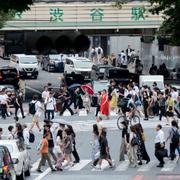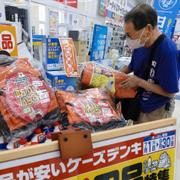
Första gången Japan varnar för ”megajordbävning”
Japan har utfärdat en varning för en möjlig ”megajordbävning”. Det är första gången sedan systemet infördes 2019, skriver Bloomberg.
Varningen kommer efter torsdagens skalv med magnituden 7,1 utanför ön Kyushu.
Den förhöjda risken har gjort att premiärminister Fumio Kishida ställt in en planerad resa till Centralasien. Tv-kanalen NHK sänder grafik som varnar för ett potentiellt jätteskalv och ett antal halvledarfabriker har pausat produktionen. Även ett antal stränder har stängts.
Konsekvenserna av torsdagens skalv har hittills varit relativt små, med 16 skadade och ett fåtal förstörda byggnader, skriver Japan Times.
bakgrund
Nankai
Wikipedia (en)
Nankai megathrust earthquakes (Japanese: 南海トラフ巨大地震, Hepburn: Nankai Torafu Kyodai Jishin) are great megathrust earthquakes that occur along the Nankai megathrust – the fault under the Nankai Trough – which forms the plate interface between the subducting Philippine Sea Plate and the overriding Amurian Plate (part of the Eurasian Plate), which dips beneath southwestern Honshu, Japan. The fault is divided into five segments in three zones, which rupture separately or in combination, and depending on location, the resulting earthquakes are subdivided by zone from west to east into Nankai earthquakes, Tōnankai earthquakes, and Tōkai earthquakes.
The earthquakes occur with a return period of about 90–200 years, and often occur in pairs, where a rupture along one part of the fault is followed by a rupture elsewhere on the fault, notably the 1854 Ansei-Tōkai earthquake and the 1854 Ansei-Nankai earthquake the next day, and the 1944 Tōnankai earthquake, followed by the 1946 Nankaidō earthquake. In one recorded case (the 1707 Hōei earthquake) the fault ruptured along its entire length. All of these great earthquakes have resulted in damaging tsunamis, which are particularly damaging due to the Japanese population being concentrated on the Taiheiyō Belt, especially the coastal cities of Tokyo, Yokohama and Osaka, the three most populous cities in Japan. The area remains seismically active, and future earthquakes are anticipated, with a high risk of a Nankai earthquake in the near future, which could be potentially very damaging.
Omni är politiskt obundna och oberoende. Vi strävar efter att ge fler perspektiv på nyheterna. Har du frågor eller synpunkter kring vår rapportering? Kontakta redaktionen


